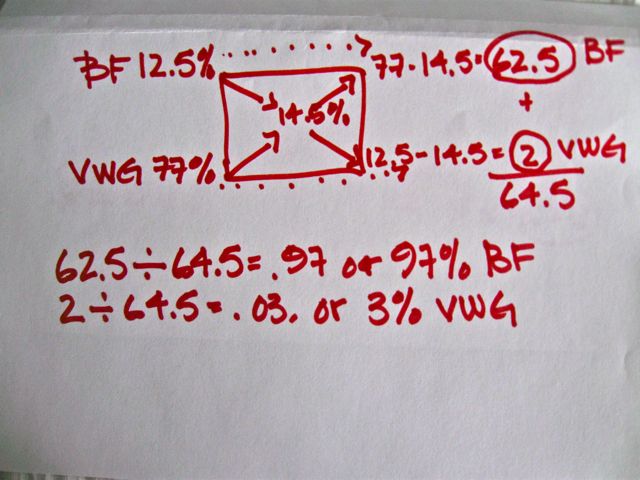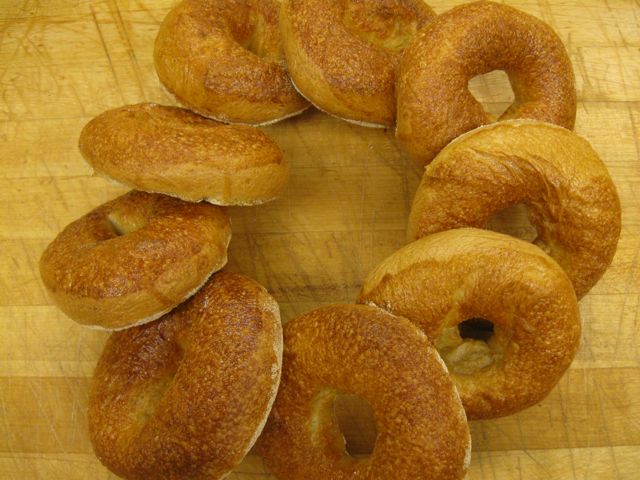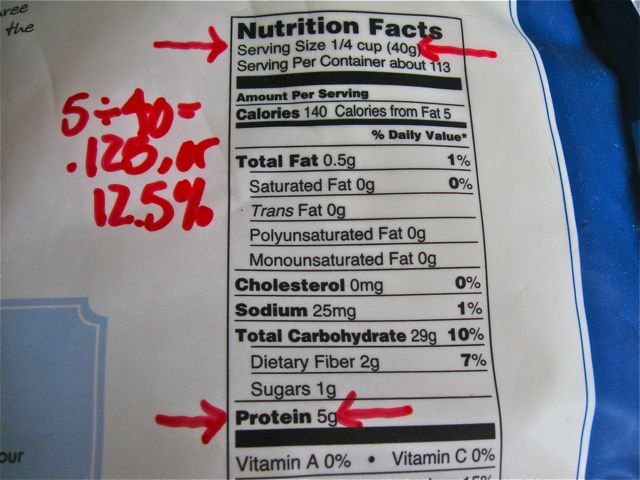
SOME USEFUL INFORMATION
What comes to mind when you think of a bagel? Is it the hole in the middle? The golden color? The chewy texture? We’ll talk about all of these. First, though, I want to talk about texture.
The dense chewiness of bagels derives from the high degree of protein in the flour used. Typically, high gluten flour should be used, sometimes also called high protein. What is “high” about it, you might ask. Good question.
Bread flour (BF) has a protein content of 12-12.5% Gluten, the  protein in flour, is literally what allows any baked good to be the best at what it is. A low protein content lets cake flour produce tenderness. Bread flour has enough protein which, during the kneading process, unfolds and expands and quite literally holds bread up. Bread flour will produce a decent bagel, but not a great one.
protein in flour, is literally what allows any baked good to be the best at what it is. A low protein content lets cake flour produce tenderness. Bread flour has enough protein which, during the kneading process, unfolds and expands and quite literally holds bread up. Bread flour will produce a decent bagel, but not a great one.
High-gluten, or high-protein flour (HPF) has a protein content of 14-14.5%. Unfortunately, it tends to be available only from large distributors in 50-pound bags. That’s a whole lot of bagels if you’re baking at home. The good news is that you can effectively create your own high protein flour.
How can know the protein content of any flour? Another good question. Let’s look at the nutrition label of a bag of bread flour.
You need two pieces of information from it: the number of grams of protein per serving, and the number of total grams of flour per serving. In this case, the numbers are 5 and 40, respectively. To learn the protein percentage, we’ll divide 5 by 40: 5 ÷ 40 = .125, or 12.5%. So we know we have bread flour, or flour that contains enough protein in the form of gluten to dependably yield a good loaf of bread.
So how do we create high protein flour? Are you familiar with vital wheat gluten (VWG)? It isn’t pure protein, but it’s darn close. I buy mine from a bulk bin at my nearby natural foods store. The grams of protein per serving are 23 (!!), and the total grams of VWG are 30 per serving. Let’s do the math: 23 ÷ 30 = .766666666666. Rounding up, let’s call it 77%. If that sounds like a lot, it is. It’s very strong stuff. If you stuffed it into a golf ball, you could hit it across state lines.
We need to know how much to add to our bread flour in order to create high protein flour. We’re going to use a tool called a Pearson’s Square. It simply allows anyone to start with two known quantities and calculate the amounts needed of each in order to create a third known quantity. Are your palms sweating? Getting short of breath? Hang in. It’s simple, and I’m going to show you why. My hand-drawn illustrations tend to look like they were done by a first-grader, so if you can get beyond that, you’ll catch on.

Take out a piece of paper, draw a square in the center, and do this with me. On the left side of the square, the smaller amount goes at the top and the larger on the bottom: 12.5 (the protein % of bread flour, BF) and 77 (the protein % of vital wheat gluten, VWG). In the center goes our target % for high-gluten flour: 14.5%.
The arrows inside the square tell you in which directions to subtract on the diagonals. We’re only concerned with integers here (it’s easier for me to calculate a Pearson’s Square than to figure out how long it’s been since I used the word “integer”), no negative numbers. The difference between 12.5 and 14.5 is 2. Write that at the bottom right corner. The difference between 77 and 14.5 is 62.5. Write that at the upper right corner. Now add the two numbers on the right together: 62.5 + 2 = 64.5. Are you with me?
There is one last step. In order to know how much of each kind of flour we need to mix together to make high protein flour, we need to know what percentage 62.5 and 2 are of the total 64.5. Because right now, the information is just in “parts”. Parts are not as useful as percentages.
So, 62.5 ÷ 64.5 = .97, or 97%
2 ÷ 64.5 = .03, or 3%
97% + 3% = 100%, so we know our numbers are accurate
In the end, I like to look at the ratios in terms of reasonableness. We’re increasing the protein content of our BF, 12.5%, to 14.5%, the protein content of HPF. We’re doing that using VWG, whose protein content is 77%. I would reasonably expect that we would need a much larger amount of BF than VWG in order to create HPF. Our calculations not only confirmed that, but also told us exactly how much of each flour we need.
Now, are you ready to make some bagels?



Oh SC, I totally shut down when it comes to math I am going to sit down with no distractions and try to figure it out, I have King Arthurs Bread flour. The answer is yes I am SO ready to make bagels but am hopeless when it comes to math. Will try my best to do the math!!
No sweat. the recipe in the next post breaks down quantities for you! I just wanted people to maybe understand how I got to them, short of sheer guesswork.
The explanation is great, I’m just an idiot when it comes to math. I’m like that cartoon of a dog when the human is talking to him it doesn’t compute. When my head is clear I am going to sit down with it and decipher the math.
The recipe post just went up. Draw a square, follow along, and you’ll easily reach the proportions posted in the recipe. By the way, I’ve again borrowed and incorporated your brilliant refrigerated proofing, with a link to your website, which I just yesterday figured out how to do!
WOW… this post is like an answer to a prayer!, May I share this post by linking to my facebook food page please>
Panfusine, you are the rice whisperer! I would be honored for your link. Thank you profoundly.
Oh, lovely, I can see a bagle making session happening in my kitchen, it’s been way too long!
Nothing like home-made!
Hi,
I am really impressed with your calculation. I will try your bagel recipe. Thank you. I also come across some spring roll skin recipes that require HPF. I will try to convert my all purpose flour to HPF. Thankyou very much.
Sophie
Thank you kindly, Sophie. I’d love to know how it,works for you.
Cynthia
Wow many thanks
Oh you are so very welcome!